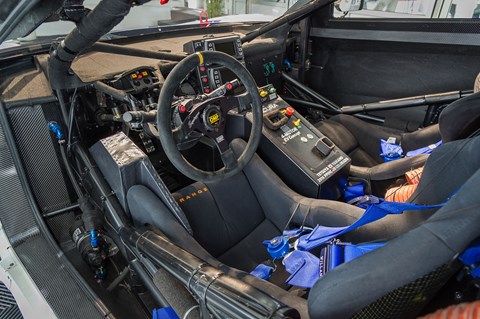► Honda hints at all-electric hypercar before 2025
► Pikes Peak racer: a 1000bhp McLaren P1 rival?
► Flagship for Honda’s Vision 2030 electric project
That Honda chose to demonstrate its 1000bhp Pikes Peak racer during a session underlining its commitment to its electric power and autonomous vehicle programmes is significant. After all, if it was going to show off its corporate might in front of the world’s senior motoring press, it would have brought along Takuma Sato and his Indy 500-winning car.
No, the company wheeled out this Acura EV Concept, which was hot off the plane from the USA after posting a scorching 9min 6.015sec run of Pikes Peak to finish third overall. It then chose to blat it down the test track at full pelt, an interesting mixture of tyre squeal, electric humming and military-grade acceleration.
Presenting the car to the press, Honda’s R&D chief Sekino Yosuke smiled as he said: ‘Our electric cars should be joyful to drive, and I would like this one to go into production. The Pikes Peak technology could be interesting.’
Why an all-electric Honda hypercar?
With 1000bhp from its four independent electric motors, overcoming the Acura EV’s 1500kg kerb weight will be a piece of cake. The Pikes Peak car is said to accelerate from 0-62mph in 2.5 seconds, and onto 124mph (200km/h) in 6.2sec. That’s a whole new ball game, and probably very joyful to drive.

As for why, Honda’s lofty ambition to become a technical leader in the electrification of cars and autonomous technology as part of its Vision 2030 programme is noble, but it lacks excitement. A car that will pull down Ferrari’s pants in silence is likely to change that perception quite effectively – rather like the original NSX supercar did back in 1989.
Where the four-motor drivetrain will really make a difference for Honda will be in how it deploys its power. According to Honda, it will feature four-wheel independent torque allocation – probably via a Power Control Unit set-up similar to that shown in the i-MMD hybrid that goes on sale in 2018.
Could that become a game-changing technology? Quite possibly. Each of the four driven wheels can accelerate or decelerate independently, giving a whole new slant on differential torque vectoring. The car’s dynamics would be infinitely adjustable to individual drivers’ preferences – and with clever programming, understeer, oversteer or neutral handling will be but a switch-flick away.
Who would buy a Honda hypercar?
Rich early adopters, non-conformists and those who want to make a statement about themselves without compromising on performance. But not only performance. Top-end electric vehicles are beginning to throw off their range anxiety issues, and Honda engineers wouldn’t put a flagship product like this out to the public unless it could do at least 250 miles on a single charge.
Read our Honda NSX review

It won’t be cheap, mind you – but in the longer term, the technology that underpins it could filter down to cheaper sports cars. Grandson of S2000, anyone?
If Honda green-lights the electric NSX replacement, don’t expect it any time soon – the company is working towards another leap in battery and charging technology. And that would probably point to around 2023, if it comes off at all.
Read all our Honda car reviews